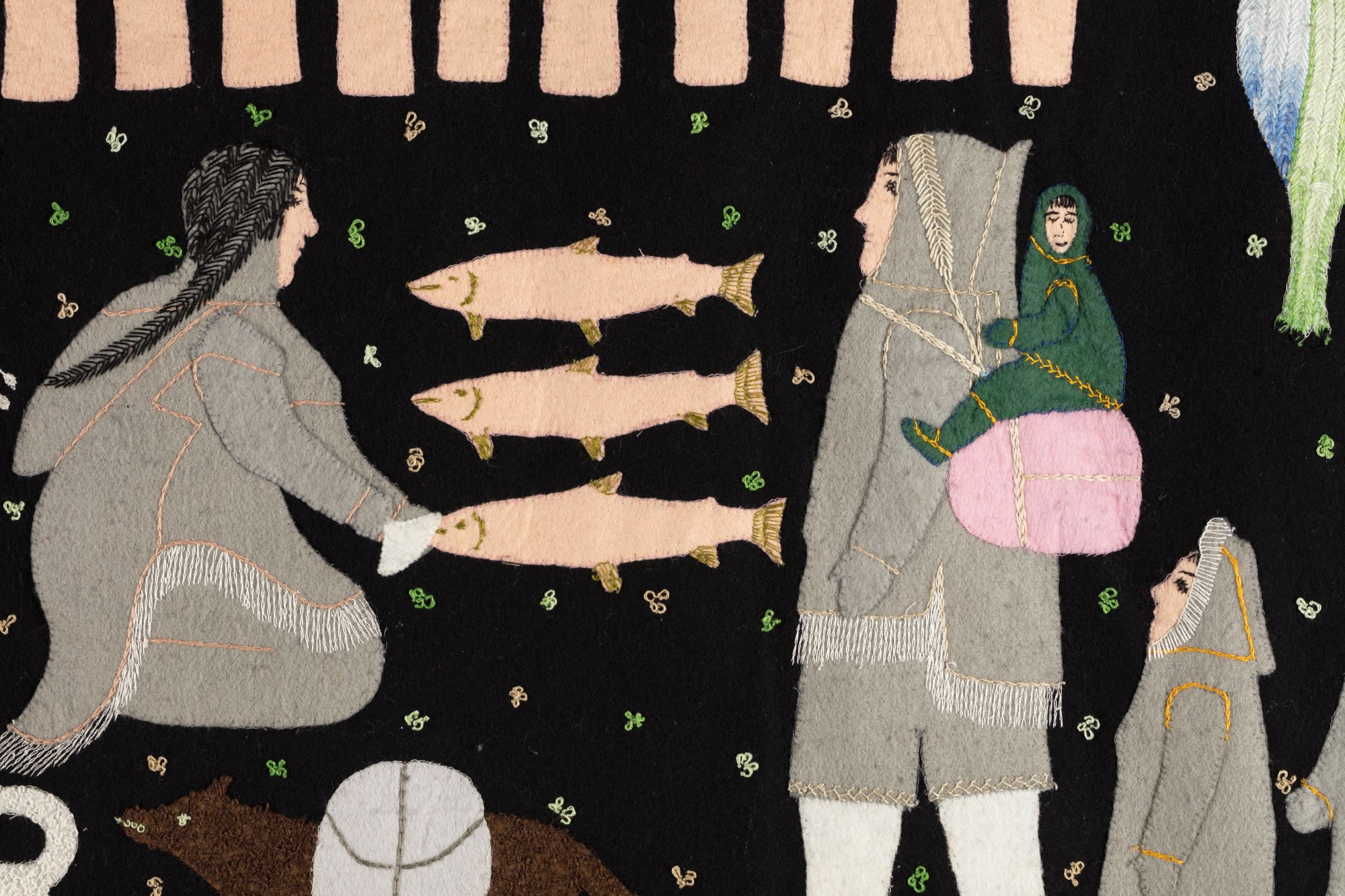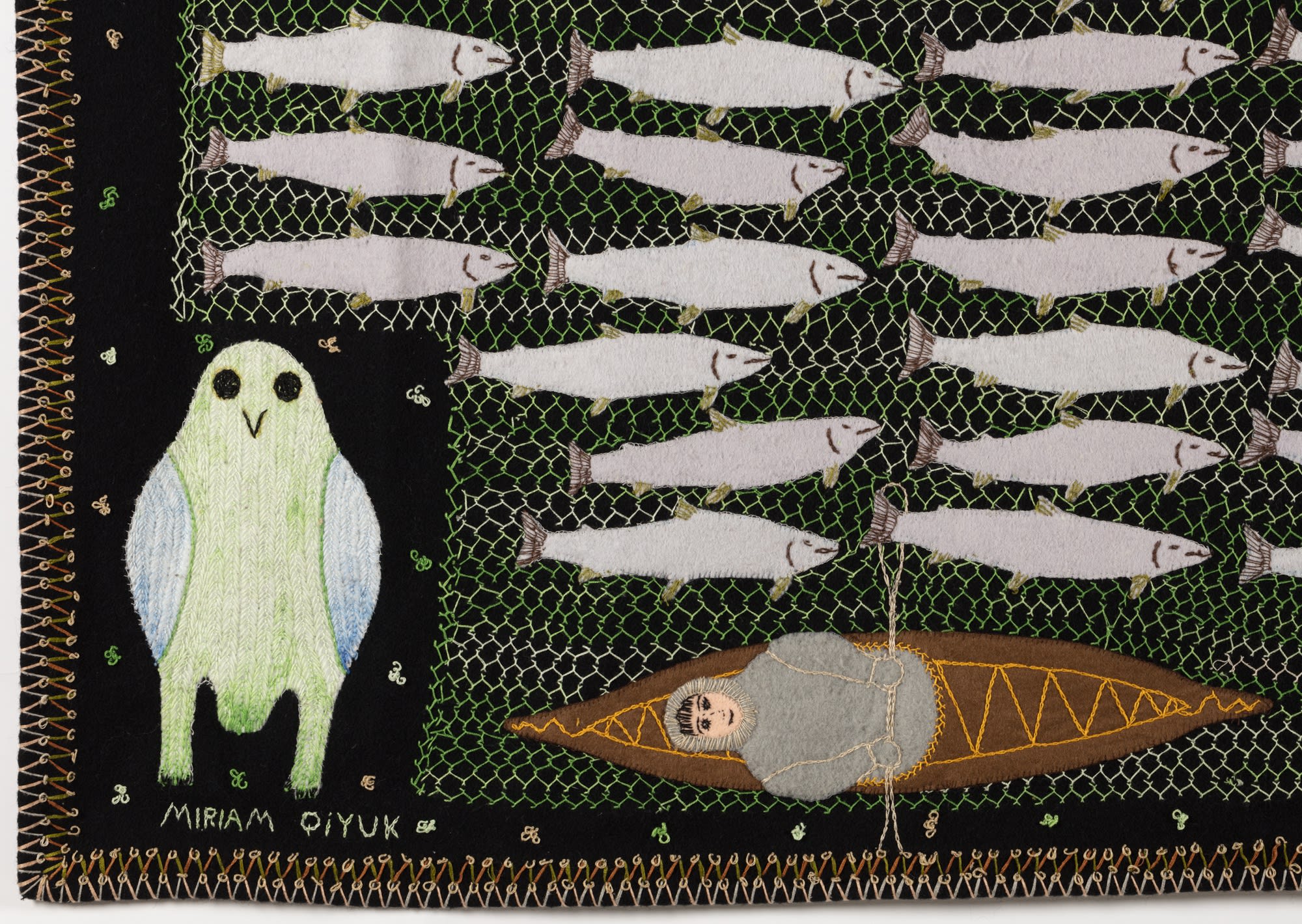We have written before about how sewing has long been an integral part of an Inuk woman’s ability to protect and provide for her family, and those around her. Now, textile work has a place as both a lifesaving practice and a beautiful artistic method to highlight skill and creativity. Nivingajuliat, or what we know to be the works on cloth often referred to simply as “wall hangings,” are a beautifully colourful and expressive form of Inuit art, often a feast for the eyes with layers of texture and stitches. In Qamani’tuaq (Baker Lake), a community now synonymous with wall hangings, artists worked out of their homes and used wool cloth, felt, and embroidery thread to create striking works of memories, myths, and the day to day.
One of Jessie Oonark’s eight surviving children (a member of the first generation of master Qamani’tuaq textile artists herself), Miriam Nanurluq Qiyuk began her artistic career in the 1960s, becoming an accomplished sculptor and sewist in the process. She became famous for her charming sculpted depictions of families in various configurations, a nod to her being absolutely devoted to her own family and children. While the theme of family groups remained important and consistent throughout her career as a sculptor (a charming example can be found in Lot 70 of this sale), the day-to-day of family life on the land became a hallmark of her textile work.

Lot 21
MIRIAM NANURLUQ QIYUK (1933 - 2016) QAMANI'TUAQ (BAKER LAKE)
Summer FIshing Camp, 2001
stroud, felt, embroidery floss, and cotton thread, 49.5 x 57.25 in (125.7 x 145.4 cm)
ESTIMATE: $10,000 — $15,000
Summer Fishing Camp is a dense depiction of subject material depicting the Arctic spring: the trek to new grounds; a skin tent rather than an igloo; catching fish at a weir; hunting caribou in open water. The work itself is a field of delicate details amongst the different tableaus, we can see the breaking of waves on the water that is finely stitched around a school of fish in the weir, and along a hunted, swimming caribou. Her animals are carefully accented with a variety of stitches, including Miriam’s familiar knotted loop stitch, which creates a wonderful fur-like texture that’s thick against the arctic wind. Figures throughout the work have beautifully thought out clothes, accented with contrasting seamlines, laid fringe along the hems, and some fuzzy hoods. While most are bundled up against the cold, three figures have their hoods down, revealing on two of them a beautiful long “braid” of stitched hair flowing behind them.


Never one to leave empty space, Miriam was known to add many finishing touches to her sewn works, including elaborate borders, or the spoils of a hunt. Throughout this collection of scenes there are multi-coloured loop stitches scattered around, perhaps early flowers on the arctic tundra, rather than spots of snow. A common accompaniment to her works are the owls acting as sentinels on the corners of the piece, standing guard over the whole affair. Their presence is usually a stylistic addition rather than a necessity to the scene, and here they sport some unnatural colourings in the green, blue, and white variegated thread to further make their presence stand apart from what’s around them. Further surrounding the work is a four colour stitched border, anchoring everything and ensuring nothing spills out of the large scene.

If you find yourself thinking that Summer Fishing Camp is familiar, the work has had a few iterations. Of the three we know of, the first dates from 1988 (see First Arts, 5 Dec. 2022, Lot 101), and this edition dates to 2001, faithfully rendered despite the decade-long span between them. A beloved work by her and fans alike, she was asked to reprise the image again and did so in 2003, although the proportions and layout of that version had some minor changes. [1]
1. See Ingo Hessel, Arctic Spirit: Inuit Art from The Albrecht Collection at the Heard Museum (Vancouver/Phoenix: D&M/Heard Museum, 2006), cat. 118, p. 133.
